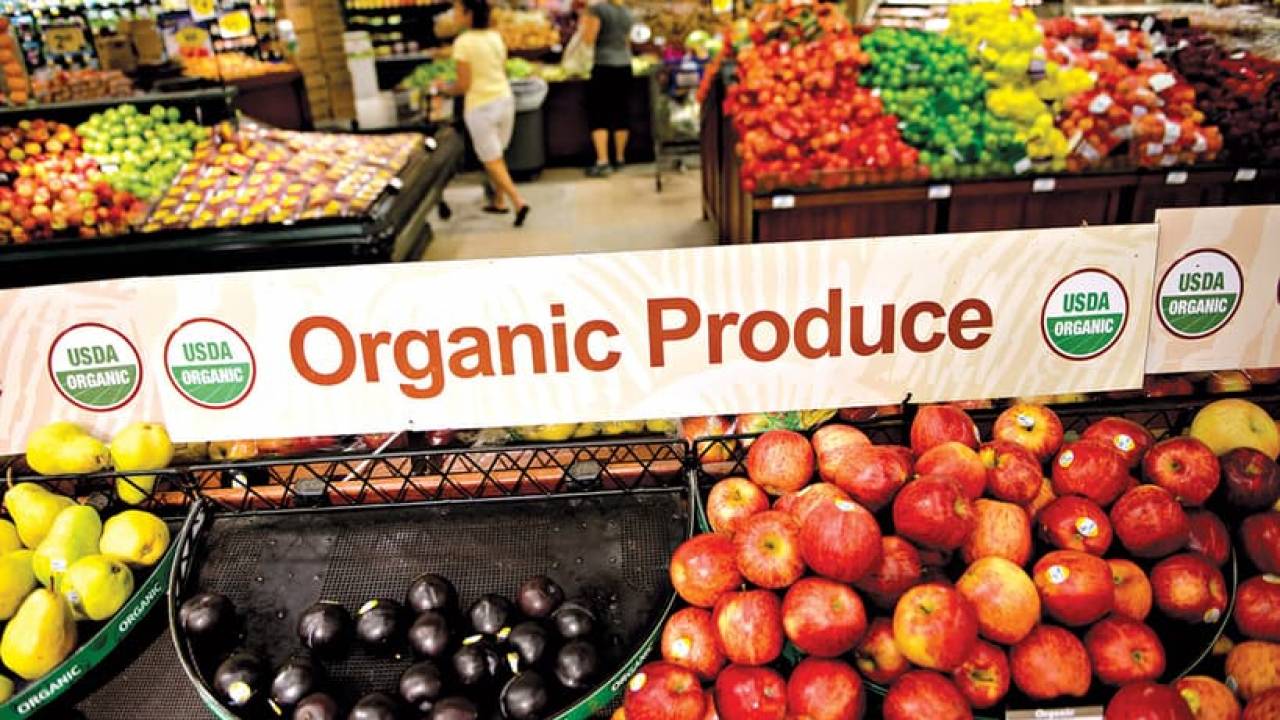Are you thinking about making the switch to organic food products? Or perhaps incorporating some organic products into your current lifestyle? The first question to ask yourself is – do you truly understand what ‘organic’ means?
When you wander around the grocery store, you’ll probably see products carrying labels that proclaim it’s either ‘natural’ or it’s ‘organic’. What do these labels mean though? What is the difference between ‘natural’ and ‘organic’? You may have assumed, like many of us do, that they’re one and the same thing but this is actually not the case. At all! So, what is the difference between ‘naturally’ and ‘organically’ produced products?
Natural – Naturally Healthy, Naturally Good For You?
‘Natural’ generally refers to a product that has not been chemically altered or synthesized in any way. Fresh fruit and vegetables, eggs, nuts, seeds, unprocessed meats and so on are examples of natural foods. Other types of natural products include skin care and health care products that are produced from all natural ingredients and do not contain synthetic chemicals. Many ‘home remedies’ are excellent examples of natural skin and health care. For example:
- Pure aloe vera gel or juice – a natural skin care remedy for treating all manner of skin issues including sunburn. Milk and raw cucumbers also help soothe and reduce inflammation caused by sunburn.
- Tomato juice – a daily glass of tomato juice helps relieve eczema
- Fresh lime juice and milk – a topical treatment for acne
- Mashed ripe banana – a great treatment for dry skin, particularly on the face and neck
- Milk bath – a monthly soak in milk is a good way to treat dry skin on the whole body. Adding a few drops of oat extract to bath water is another option.
- Sour cream – a great way to treat shaving rash.
- Tea tree oil – a powerful antiseptic
- Garlic – a natural antibiotic and antiseptic
- Eucalyptus oil – another natural antibiotic and antiseptic. Also a good cleaning agent.
- Apple cider vinegar or red clover – a natural treatment (consumed not topical) for a range of allergies
- Cannabidiol – also known as CBD oil, this is probably one of the most powerful natural treatments for a huge range of health disorders
You will also find many natural cleaning products available. Vinegar and lemon juice for example are two of the most effective and well-known natural cleaning agents. Then there are natural pest repellents like mint, eucalyptus oil, cloves, lavender, rosemary, citronella, and cedar oil or cedar wood. Natural pet foods are fast becoming popular for our four-legged family members, particularly ones that are prone to allergies. Indeed, the list of ‘natural’ products and remedies is almost endless. Incorporating as many natural products as you possibly can into your life is a great, and healthy, way to live.
Natural – Up To A Point
If you’re interested in organic however there are several important, and major, distinctions between natural and organic products. Apart from not being chemically modified or artificially synthesized, there are still no real official criteria in most countries governing HOW natural products are grown and processed.
Therefore, ‘natural’ products can still be grown in petroleum-based fertilizers or treated with synthetic herbicides and pesticides for example, things prohibited by legislation in organic products. Few countries have any significant regulations around exactly what qualifies something to be labelled as a ‘natural’ product.
Therefore, producers and manufacturers can, and do, put their own interpretations on what they can get away with labelling as ‘natural’ even though their products may be highly processed! For you, the end user, there’s generally no way of really knowing just how many chemicals and processing methods have been employed in the production of that item.
Organic Products On The Other Hand….
Organic production by contrast is very heavily regulated. Organic legislation decrees that products labelled ‘organic’ must be certified free of synthetic herbicides and pesticides, petroleum based fertilizers, growth hormones, antibiotics and a host of other ‘nasties’. The soil that produces organic produce, including animals and poultry, must not contain any toxic chemicals or chemical residues and this must be tested and proven before a farm will be certified organic. Organic food cannot be processed using any methods that involve genetic modification, industrial solvents or irradiation. They can’t contain any artificial flavors, colors or preservatives.
Animals involved in organic production ie meat, dairy, eggs, must be raised in a natural free-range environment that closely simulates the way nature intended them to live. They must be fed organically produced feeds and graze organic grass growing in organic soils. They can’t be fed growth hormones or antibiotics. Associated pest control methods used in their care and maintenance must likewise be organic.
Organic producers and processors can be inspected at any time, and these inspections can be unannounced. Organic establishments found to be violating organic labeling rules can be hit with large penalty fees and fines in some countries. None of these measures apply to products labelled ‘natural’.
Incidentally, that list of ‘natural’ home remedies can also be turned into a list of ‘natural organic’ home remedies simply by ensuring the ingredients you’re using are certified organic!
What’s In A Label – USDA Organic Labeling
In the US, you’ll see a few types of organic labels on certified organic food products and they come with strict guidelines. A “USDA Organic” or “Certified Organic” seal means the product must display a list of the ingredients. It also means the product itself must be 95% or more certified organic, meaning it’s free of all the nasties listed above and has been grown and produced in accordance with organic regulations. The other 5% must be foods or compounds ie additives that are on an approved list. A “100% Organic” label means the product is 100% free of any disallowed substances and has been grown and processed entirely organically.
The other type of organic label you may see is ‘Made with Organic’. These products must be at least 70% organic with the remainder being ingredients that are not on an exclusion list maintained by the USDA. ‘Made with Organic’ products are also not allowed to display the USDA Organic seals. Then there are products that have 70% or less organic ingredients. These products are only allowed to use the word ‘organic’ in their list of ingredients.
Natural Vs Organic – The Nuts And Bolts
To sum up – products labelled ‘natural’ must not have been chemically altered or synthesized in any way. Outside those broad specifications there are very few regulations governing what can and can’t be labelled a ‘natural’ product. Fresh fruits and vegetables grown with petroleum-based fertilizers and sprayed with synthetic herbicides and pesticides for example are still classed as ‘natural’ foods. The end consumer has no way of knowing what chemicals and other ‘nasties’ have been employed in the production and processing of that product. However, official testing of ‘natural’ products has determined that they do not contain enough chemicals of any significance to harm humans. So you’re not necessarily going to be poisoned the next time you eat fresh fruit and veggies labelled ‘natural’ rather than ‘organic’!
Likewise, animals used to produce ‘natural’ foods can still live on feedlots or in other unnatural environments and the consumer has no way of knowing how that animal, or bird, lived. ‘Free-range’ for instance in respect to eggs and poultry products doesn’t necessarily mean the hens are truly free-range. It just means they’re not locked in cages!
By comparison, to earn the right to be labelled ‘organic’, organic producers and processors must abide by stringent quality control guidelines set down by governing bodies. Organic products may not be grown in or on anything other than certified organic soils or be treated with anything other than certified organic herbicides and pesticides. Plus meet a whole host of other requirements. The end consumer is assured that the product is free of potentially toxic synthetic substances, has not been genetically modified, has been produced sustainably and doesn’t contain any artificial substances or compounds. If an animal product, organic means it has been grown in a natural, humane environment. Free-range truly means free-range!
Organic Production Is All About Environmental Sustainability
Another fundamental underlying principle behind organic production methods is that they are intended to be environmentally sustainable by promoting and conserving biodiversity and ecological balance. Using natural fertilizers like animal manures recycles resources for example and functions in harmony with nature.
Organic foods also taste better but when it comes to nutrition, research to date indicates that there are no real differences between food produced organically, naturally or ‘normally’. So an organic orange is still going to give you roughly the same nutrition as a ‘naturally grown’ orange and even a commercially grown orange. It’s just that you’ll likely enjoy eating the organic one more than the others – for all sorts of reasons, not the least of which is taste!





